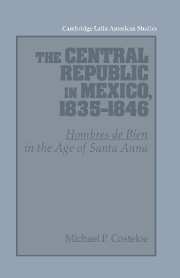Book contents
- Frontmatter
- Contents
- Preface
- Acknowledgements
- 1 An introduction: change and continuity in the Age of Santa Anna
- 2 The end of federalism
- 3 The transition to centralism: stage I
- 4 The transition to centralism: stage II
- 5 Las Siete Leyes
- 6 Anastasio Bustamante and the centralist republic, 1837–1839
- 7 Santa Anna versus Bustamante: the end of the Siete Leyes, 1839–1841
- 8 ‘La dictadura disfrazada con el hermoso nombre de regeneración política’
- 9 Santa Anna and the Bases Orgánicas
- 10 ‘La revolución de tres horas’
- 11 Herrera and the rise of Paredes y Arrillaga
- 12 Hombres de bien and the restoration of federalism
- 13 Conclusion
- Sources and works cited
- Index
- CAMBRIDGE LATIN AMERICAN STUDIES
12 - Hombres de bien and the restoration of federalism
Published online by Cambridge University Press: 23 October 2009
- Frontmatter
- Contents
- Preface
- Acknowledgements
- 1 An introduction: change and continuity in the Age of Santa Anna
- 2 The end of federalism
- 3 The transition to centralism: stage I
- 4 The transition to centralism: stage II
- 5 Las Siete Leyes
- 6 Anastasio Bustamante and the centralist republic, 1837–1839
- 7 Santa Anna versus Bustamante: the end of the Siete Leyes, 1839–1841
- 8 ‘La dictadura disfrazada con el hermoso nombre de regeneración política’
- 9 Santa Anna and the Bases Orgánicas
- 10 ‘La revolución de tres horas’
- 11 Herrera and the rise of Paredes y Arrillaga
- 12 Hombres de bien and the restoration of federalism
- 13 Conclusion
- Sources and works cited
- Index
- CAMBRIDGE LATIN AMERICAN STUDIES
Summary
The rise of Paredes to the supreme executive power was an appropriate culmination of the centralist decade. Conservatives like Alamán were once again in control, and they saw in him the ideal candidate to represent their views. Unlike the weak Bustamante or the mercurial and unprincipled Santa Anna, Paredes represented unequivocally the values of the conservative hombre de bien. As indicated in previous chapters of this study, he was strongly proclerical and nostalgic for what he saw as the social and moral stability of the colonial era. Moreover, he shared the priorities of all hombres de bien regarding such matters as law and order and education. More than anything, however, he believed that only property owners, or the ‘well-off classes’, as he termed them, were fit to govern, and he despised both the proletariat and especially those renegades of his own social class who advocated popular suffrage or sovereignty.
Paredes seemed, therefore, ideally placed to carry out at last the conservative programme, which was once again restated in the press in an attempt to persuade the uncommitted hombres de bien where their true interests lay. A new daily paper, El Tiempo, appeared on the streets for the first time on 24 January, and while its main objective was soon admitted to be the creation of a monarchy, its early articles expounded the same ideology as its conservative predecessors had done in 1830–2 and 1834–6.
- Type
- Chapter
- Information
- The Central Republic in Mexico, 1835–1846'Hombres de Bien' in the Age of Santa Anna, pp. 284 - 297Publisher: Cambridge University PressPrint publication year: 1993



